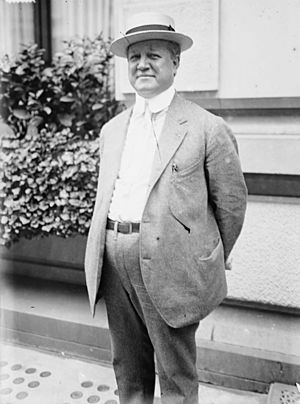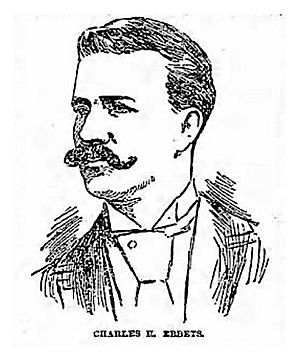Charles Ebbets facts for kids
Quick facts for kids
Charles Ebbets
|
|
|---|---|

Charles H. Ebbets Sr., circa 1915
|
|
| Born | October 29, 1859 New York City
|
| Died | April 18, 1925 (aged 65) New York City
|
| Occupation | Architect; owner of Brooklyn Dodgers |
Charles Hercules Ebbets, Sr. (born October 29, 1859 – died April 18, 1925) was an important American sports leader. He was a co-owner of the Brooklyn Dodgers baseball team from 1897 to 1902. After that, he became the main owner until he passed away in 1925. He also served as the President of the Brooklyn Dodgers from 1898 to 1925.
Contents
About Charles Ebbets
Charles Ebbets was born in New York City on October 29, 1859. His father, John B. Ebbets, owned a tavern. His mother was Anna Maria Quick. Charles went to school in New York City.
After school, he worked for a publishing company. Then, he became an architect, designing buildings. This skill later helped him when he decided to build a baseball stadium. He also worked as a bookkeeper before focusing on baseball.
Besides baseball, Charles Ebbets loved bowling. He was a member of several bowling clubs and was known as a very good bowler in Brooklyn.
Building the Brooklyn Dodgers
In 1883, Charles Ebbets started working for the Brooklyn Base Ball Association. He sold tickets, score cards, and peanuts at their stadium, Washington Park. He even printed the score cards himself! The team, then called the Brooklyn Bridegrooms, moved to bigger fields over the years.
By 1890, Ebbets had saved enough money to buy a part of the team. He kept buying more shares whenever he could. By 1898, he owned 80 percent of the team. When the club's president, Charles H. Byrne, passed away, Ebbets was elected president on January 13, 1898.
Under his leadership, the team, now sometimes called the Superbas, won the National League championship in 1899 and again in 1900.
Building Ebbets Field
Charles Ebbets knew the old Washington Park stadium wasn't good enough. It was made of wood and smelled bad because it was near factories. He wanted a modern stadium. He looked around Brooklyn and found an area in Flatbush called "Pigtown." It was a good spot because many trolley lines met there, making it easy for fans to get to games.
Quietly, over four years, he bought small pieces of land in Pigtown. By 1911, he owned enough land for a stadium.
In 1912, he sold half of his team shares to get money to build the new stadium. It cost $750,000. The new 25,000-seat stadium, named Ebbets Field in his honor, opened on April 9, 1913. Even though the Superbas lost their first game there, it was a big day for Brooklyn baseball.
Baseball Success
Ebbets' team, later known as the Robins (after their manager, Wilbert Robinson), won the National League championship in 1916. They played in the 1916 World Series but lost to the Boston Red Sox. Four years later, in 1920, the Robins won the championship again. They went to the 1920 World Series but lost to the Cleveland Indians.
Later Life and Passing
In 1922, Charles Ebbets married Grace Slade. They built a house in Clearwater, Florida, and he moved the Dodgers' spring training there.
In April 1925, after returning from spring training, Charles Ebbets became unwell. He passed away from heart failure on April 18, 1925, at the age of 65. His funeral was held at Trinity Church, and he was buried in Green-Wood Cemetery in Brooklyn. On the day of his funeral, all baseball games in the National League were canceled to honor him. Flags at all National League parks flew at half-staff for 30 days.
His Legacy in Baseball
Charles Ebbets was a very involved owner who brought many new ideas to baseball. Some of his ideas are still used today:
- Ladies Day: In 1899, he started "Ladies Day," where women could get into the ballpark for a lower price.
- Longer Season: In 1904, he helped change the Major League Baseball schedule from 140 to 154 games.
- Better Facilities: In 1906, he made sure teams had separate batting and fielding practices. He also added separate dressing rooms with lockers and running water for both home and visiting teams. Before this, visiting teams often arrived already dressed from their hotels.
- Rain Check: In 1911, he created the "rain check." This allowed fans to use a part of their ticket for another game if a game was canceled due to rain.
- Player Draft: Two years later, he suggested the idea of a player's draft. This meant the team with the worst record would get the first picks for new players.
- Uniform Numbers: In 1917, he had his team and the Boston Red Sox wear numbers on their sleeves during an exhibition game. He thought fans in smaller cities might not know the players. He suggested all teams put numbers on uniforms, but it didn't become common until 1929.
- World Series Format: In 1925, he helped make the 2-3-2 game pattern for the World Series a permanent rule. This format is still used today.
Charles Ebbets hoped his team would win a championship in his stadium. He saw them win two National League championships (1916 and 1920) at Ebbets Field, but they never won the World Series during his lifetime. The Dodgers finally won the World Series in 1955. Ebbets Field was torn down in 1958, and apartments now stand where the stadium once was.
His estate was worth a lot of money, mostly from his ownership of the Dodgers and Ebbets Field. His will said his shares in the Dodgers should be sold together. It took many years for his estate to be fully settled, finally happening in 1949.
Timeline
- 1883: Started working for the Brooklyn baseball team.
- 1898: Became President and manager of the team.
- 1899: Team won the National League championship.
- 1900: Team won the National League championship again.
- 1912: Ebbets Field was built.
- 1916: Team won the National League championship.
- 1920: Team won the National League championship again.
See also
- Honor Rolls of Baseball


